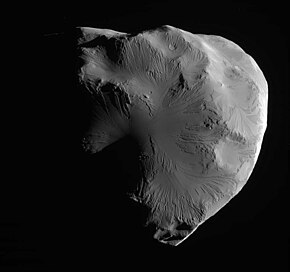 | |
| Discovery[1] | |
|---|---|
| Discovered by | P. Laques J. Lecacheux |
| Discovery site | Pic du Midi Observatory |
| Discovery date | March 1, 1980 |
| Designations | |
Designation | Saturn XII |
| Pronunciation | /ˈhɛləniː/[2] |
Named after | Helen of Troy (Ἑλένη Helenē) |
| |
| Adjectives | Helenean /hɛləˈniːən/[3] |
| Orbital characteristics | |
| 377600 km[4] | |
| Eccentricity | 0.007[4] |
| 2.736916 d[4] | |
| Inclination | 0.199° (to Saturn's equator) |
| Satellite of | Saturn |
| Group | L4 Dione trojan |
| Physical characteristics | |
| Dimensions | 45.2 × 39.2 × 26.6 km (± 0.4 × 0.6 × 0.4 km)[5] |
| 36.2±0.4 km[5] | |
| Volume | 24840 km3[a] |
| Mass | (7.1±0.2)×1015 kg[6] |
Mean density | 0.2926±0.0217 g/cm3[6] |
| 0.0009 m/s2 at longest axis to 0.0027 m/s2 at poles | |
| 0.0065 km/s at longest axis to 0.0084 km/s at poles | |
| assumed synchronous | |
| zero | |
| Albedo | 1.67±0.20 (geometric)[7] |
Helene /ˈhɛləniː/ is a moon of Saturn. It was discovered by Pierre Laques and Jean Lecacheux in 1980 from ground-based observations at Pic du Midi Observatory,[1] and was designated S/1980 S 6.[8] In 1988 it was officially named after Helen of Troy, who was the granddaughter of Cronus (Saturn) in Greek mythology.[9] Helene is also designated Saturn XII (12), which it was given in 1982, and Dione B,[10] because it is co-orbital with Dione and located in its leading Lagrangian point (L4). It is one of four known trojan moons.

Polydeuces · Helene · Dione · Saturn
- ^ a b Lecacheux1980.
- ^ John Walker (1839) A Critical Pronouncing Dictionary and Expositor of the English Language;
also per "Helena". Oxford English Dictionary (Online ed.). Oxford University Press. (Subscription or participating institution membership required.) - ^ Clarified as Helenéan in Earle (1841) Marathon: and other poems, p. 76.
- ^ a b c Cite error: The named reference
jpl-satelemwas invoked but never defined (see the help page). - ^ a b c Thomas & Helfenstein 2020, p. 2.
- ^ a b Jacobson 2022, p. 6.
- ^ Verbiscer et al. 2007.
- ^ IAUC 3496.
- ^ IAUC 4609.
- ^ Transactions of the International Astronomical Union, Vol. XVIIIA, 1982 (mentioned in IAUC 3872: Satellites of Jupiter and Saturn, September 30, 1983
Cite error: There are <ref group=lower-alpha> tags or {{efn}} templates on this page, but the references will not show without a {{reflist|group=lower-alpha}} template or {{notelist}} template (see the help page).